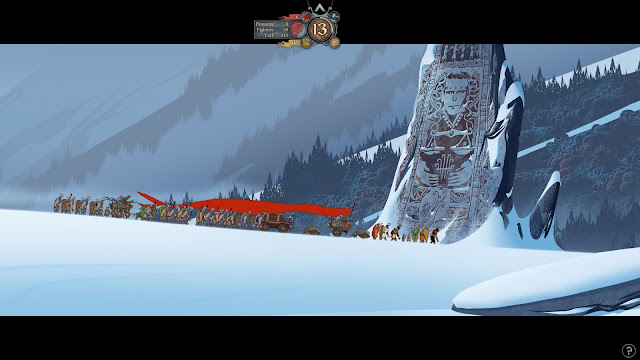Rating: 8.7
Happy Price: 9.99
Gameplay
Banner Saga is a turn based tactical RPG. It deals with a max party of six warriors of different classes, each with a unique ability. It is seldom you will find two warriors with the same ability, creating a unique combination of tactics that can be used depending on who is in the player's party. It also focuses on asset management and dialogue choices similar to Oregon Trail.
Combat System
Banner Saga created a system I had never seen before. There are two attributes to each warriror, strength and armor. Strength is also the users health. The way the system works is, if a user has a strength of 7, but the opponent has an armor of 8, there is a percentage chance that the attack won't hit. If strength is 7, and armor is 6, damage is guaranteed, but will probably do little damage. The lower the armor of the opponent, and higher strength of attacker, the more damage done. Some classes are designed to do more damage to armor, and others strength, so it's good strategy to mix these classes together.
Another unique thing was instead of one party having a turn, then the other party makes all their moves, there is a turn order based on individuals from each party. This creates interesting scenarios, because if you have a situation where it is 4v2, both sides have the same amount of moves in a given time. The person with four people in their party will make their four moves with each party member. The person with two people in their party will also move four times in the same span, but only with 2 party members. The strategy I used was take out the most powerful opponents first, that way as time went on weaker opponents got more moves instead of having powerful ones at the end going over and over again.
Party Management
Unlike an unforgiving game like Fire Emblem, your characters don't die for good in this game. If a party member reaches zero health, they are injured for a set amount of days. This injury imposes a penalty if they are not healed until the next battle. Even if a battle is lost, the game does not stop. The story changes instead which is something that defies what most RPGs do. Of course there is a negative impact to losing so it should be avoided at all costs, but it's not something that isn't salvageable. Based on decisions you make during dialogue, party members my leave or join your caravan. You must be very careful when deciding who to level up in this regard. If there is tension with a character, it is not wise to use them much when you can level someone else that appears to be more loyal. I had a situation early game where one of my top members wanted to leave, and I had to swallow my pride for him to stay.
The Journey
The Oregon Trail aspect creates tension throughout the entire experience. Since there is a currency known as "renown" that is used to promote party members to new levels, and also used to purchase supplies, you have to constantly have that battle on what to do. If you run out of supplies, caravan members starve to death and die. If you don't level up your characters when they are eligible, you risk losing battles. Most of the dialogue and minute decision making also happens on the journey from one town to another. There is great opportunity to increase renown and supplies in the moments of travel. However the wrong decisions can doom the caravan and have everlasting effects. Each decision has to be meticulously analyzed.
Artwork
The artwork and animations are hand drawn and it all looks amazing. This is high grade production that rivals Disney classic movies like Lion King or Cinderella. It creates a beautiful setting amidst the dread of trekking through snowfall on the verge of starving to death. It's difficult to tell if animations we're re-used by multiple characters, but from what I can tell they are unique. I used four different archers and they all had different stances and ways they shot their bows. You can't say enough about hand drawn video games, they are incredibly difficult to make and something that is seldom done for those reasons.
Narrative
One of the focal points is the story. It is incredibly complex and deep, with a large amount of characters to follow and many regions are talked about. They are all Nordic names and regions and it can be difficult to follow. I found I never really found certain characters to have a "voice" I could imagine in my head. Also, the presentation of the narrative could be confusing. At times I could not tell who was talking or saying what. I could see two people are talking to one another and understood what was going on, but when two people of the same faction we're talking it was hard to distinguish one personality from another. The story is incredibly engaging and helps get addicted to the gameplay as you want the story to progress.
Summary
It caters to an older more mature audience as it deals with complex dialogue and narrative that one must follow closely. Combat is innovative and the artwork is some of the best in any video game. It's a short game that will be around 9-12 hours depending on the player, and if you want to replay it for different outcomes. If you like tactical RPG's, this is a must have. However it's very difficult and new people to the genre will have a hard time.




